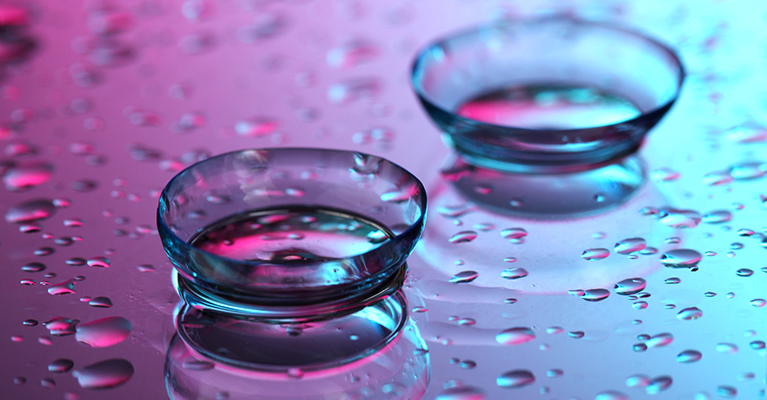Diabetes diagnosis - now a matter of sweat and tears?

No need to draw blood; researchers develop smart technology to diagnose diabetes and treat diabetic retinopathy.
A research team from POSTECH has developed technology that allows diagnosis of diabetes and treatment of diabetic retinopathy just by wearing ‘Smart Light-emitting diode (LED) Contact Lens.’
Professor Sei Kwang Hahn and his research team have invented a smart photonic contact lens and a wearable medical device which can diagnose diabetes and treat diabetic retinopathy. Their new research results on photonic diagnosis and photonic therapy of diabetes are published on-line in Nature Reviews Materials in collaboration with a research group led by Zhenan Bao from Department of Chemical Engineering at Stanford University and David Myung from Stanford Medicine Ophthalmology.
The smart contact lens with integrated micro-LED and photodetector can measure glucose concentration in the conjunctival blood vessels by analysing the NIR light which, in turn, helps with diabetic diagnosis.
The team applied its new smart LED contact lenses to rabbits with diabetic retinopathy disease and irradiated light repeatedly for a month. This resulted in a significant reduction of angiogenesis (production of new blood vessels) in the retina and verified clinical feasibility of the smart LED contact lens for the diabetic retinopathy therapy.
This newly developed device will allow diabetic patients to monitor their blood-sugar level in real-time; it also enables medical treatment for retinopathy which is caused by diabetic complications.
Meanwhile, Professor Hahn and his research team have also developed a smart contact lens that can diagnose diabetes by analysing glucose concentration in tears and deliver drugs to treat diabetic retinopathy. Preliminary clinical tests for the developers are expected to be done in the first half of this year.
On the basis of these results, they have also developed a smart wearable medical device that can analyse glucose concentration in sweat and they verified, which could also be clinically feasible for diabetic diagnosis. Furthermore, in conjunction with PHI Biomed, they developed a blue-tooth system that can send data wirelessly allowing patients to check their diabetic diagnosis results on their mobile phones.
Professor Hahn commented: “We developed a smart LED contact lens that can diagnose diabetes and treat diabetic retinopathy with light for the first time in the world. We are planning to commercialize these smart contact lenses and smart wearable medical devices in collaboration with Stanford Medicine.”
Related News
-
News Patients vs Pharma – who will the Inflation Reduction Act affect the most?
The Inflation Reduction Act brought in by the Biden administration in 2022 aims to give better and more equitable access to healthcare in the USA. However, pharma companies are now concerned about the other potential costs of such legislation. -
News CPHI Podcast Series: What does the changing US Pharma market mean for industry and patients alike?
In this week's episode of the CPHI Podcast Series Lucy Chard, Digital Editor for CPHI Online is joined by James Manser to discuss the political and market changes in the US pharma field. -
News CPHI Barcelona Annual Report illuminates industry trends for 2024
The CPHI Annual Survey comes into it’s 7th year to report on the predicted trends for 2024. Over 250 pharma executives were asked 35 questions, with their answers informing the industry landscape for the next year, spanning all major pharma marke... -
News Which 10 drugs are open to price negotiation with Medicare in the USA?
The Centres for Medicare & Medicaid Services, under the Biden administration in the USA, has released a list of the 10 drugs that will be open to price negotiations as part of the new legislation under the Inflation Reduction Act (IRA). -
News EU Medical Devices Regulation causes unintended disappearances of medical devices for children, doctors state
Doctor groups and associations have appealed to the EU to correct the EU Medical Devices Regulation law that may cause unintended shortages of essential drug and medical devices for children and rare disease patients. -
News 10 Major Drug Approvals So Far in 2023
Last year, 37 novel drugs were approved by the FDA, this was a high number for such a category, and covered many fields including oncology, demonstrating how promising further research is, and how it is only continuing to build. To date, there are alre... -
News Detecting Alzheimer's disease with a simple lateral flow test
A novel rapid diagnostic test for early-stage Alzheimer's disease has been developed using a biomarker binder from Aptamer Group along with technology from Neuro-Bio, the neurodegenerative disease experts. -
News CPHI Podcast Series: outsourcing and manufacturing trends
Listen to the CPHI Podcast Series this June to hear Gil Roth of the PBOA speak with Digital Editor Lucy Chard about the biggest trends and topics to watch in pharma outsourcing and manufacturing at the minute.
Position your company at the heart of the global Pharma industry with a CPHI Online membership
-
Your products and solutions visible to thousands of visitors within the largest Pharma marketplace
-
Generate high-quality, engaged leads for your business, all year round
-
Promote your business as the industry’s thought-leader by hosting your reports, brochures and videos within your profile
-
Your company’s profile boosted at all participating CPHI events
-
An easy-to-use platform with a detailed dashboard showing your leads and performance







